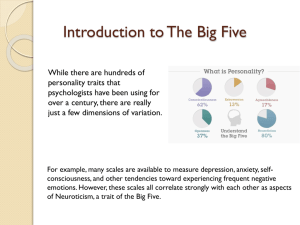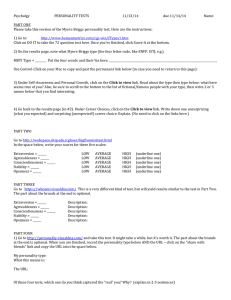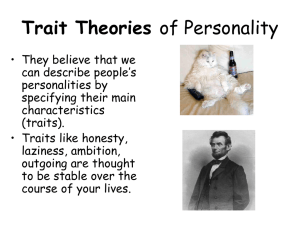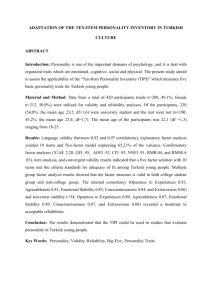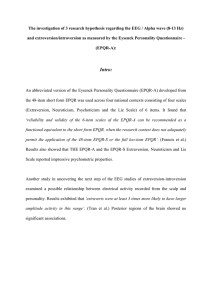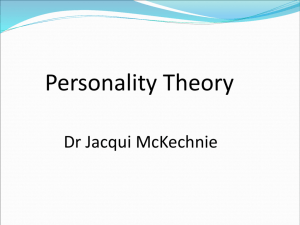Extraversion, emotional instability, and self-reported exercise: The
advertisement
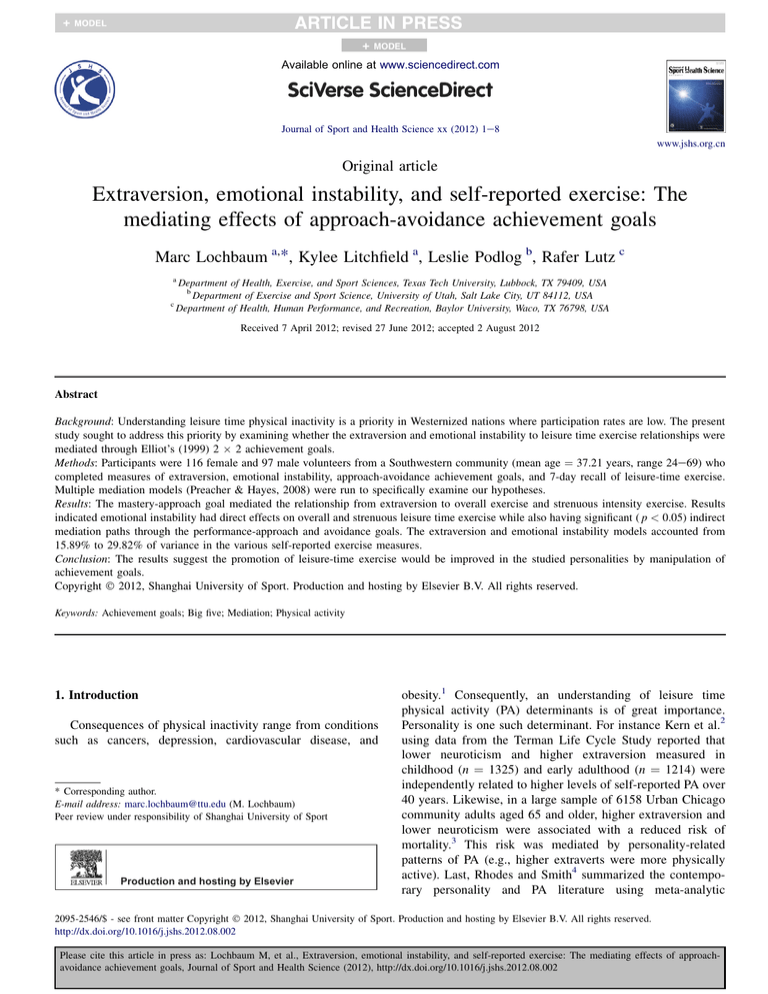
+ MODEL Available online at www.sciencedirect.com Journal of Sport and Health Science xx (2012) 1e8 www.jshs.org.cn Original article Extraversion, emotional instability, and self-reported exercise: The mediating effects of approach-avoidance achievement goals Marc Lochbaum a,*, Kylee Litchfield a, Leslie Podlog b, Rafer Lutz c a Department of Health, Exercise, and Sport Sciences, Texas Tech University, Lubbock, TX 79409, USA b Department of Exercise and Sport Science, University of Utah, Salt Lake City, UT 84112, USA c Department of Health, Human Performance, and Recreation, Baylor University, Waco, TX 76798, USA Received 7 April 2012; revised 27 June 2012; accepted 2 August 2012 Abstract Background: Understanding leisure time physical inactivity is a priority in Westernized nations where participation rates are low. The present study sought to address this priority by examining whether the extraversion and emotional instability to leisure time exercise relationships were mediated through Elliot’s (1999) 2 2 achievement goals. Methods: Participants were 116 female and 97 male volunteers from a Southwestern community (mean age ¼ 37.21 years, range 24e69) who completed measures of extraversion, emotional instability, approach-avoidance achievement goals, and 7-day recall of leisure-time exercise. Multiple mediation models (Preacher & Hayes, 2008) were run to specifically examine our hypotheses. Results: The mastery-approach goal mediated the relationship from extraversion to overall exercise and strenuous intensity exercise. Results indicated emotional instability had direct effects on overall and strenuous leisure time exercise while also having significant ( p < 0.05) indirect mediation paths through the performance-approach and avoidance goals. The extraversion and emotional instability models accounted from 15.89% to 29.82% of variance in the various self-reported exercise measures. Conclusion: The results suggest the promotion of leisure-time exercise would be improved in the studied personalities by manipulation of achievement goals. Copyright Ó 2012, Shanghai University of Sport. Production and hosting by Elsevier B.V. All rights reserved. Keywords: Achievement goals; Big five; Mediation; Physical activity 1. Introduction Consequences of physical inactivity range from conditions such as cancers, depression, cardiovascular disease, and * Corresponding author. E-mail address: marc.lochbaum@ttu.edu (M. Lochbaum) Peer review under responsibility of Shanghai University of Sport Production and hosting by Elsevier obesity.1 Consequently, an understanding of leisure time physical activity (PA) determinants is of great importance. Personality is one such determinant. For instance Kern et al.2 using data from the Terman Life Cycle Study reported that lower neuroticism and higher extraversion measured in childhood (n ¼ 1325) and early adulthood (n ¼ 1214) were independently related to higher levels of self-reported PA over 40 years. Likewise, in a large sample of 6158 Urban Chicago community adults aged 65 and older, higher extraversion and lower neuroticism were associated with a reduced risk of mortality.3 This risk was mediated by personality-related patterns of PA (e.g., higher extraverts were more physically active). Last, Rhodes and Smith4 summarized the contemporary personality and PA literature using meta-analytic 2095-2546/$ - see front matter Copyright Ó 2012, Shanghai University of Sport. Production and hosting by Elsevier B.V. All rights reserved. http://dx.doi.org/10.1016/j.jshs.2012.08.002 Please cite this article in press as: Lochbaum M, et al., Extraversion, emotional instability, and self-reported exercise: The mediating effects of approachavoidance achievement goals, Journal of Sport and Health Science (2012), http://dx.doi.org/10.1016/j.jshs.2012.08.002 + 2 techniques and reported positive albeit small in magnitude relationships between extraversion and exercise, and a negative relationship between neuroticism and PA. Hence, personality is a determinant of PA. Given the distal nature of personality to actual behavior, researchers have included personality traits within a number of frameworks as some intervening or mediating variables are necessary to explain the personality/exercise relationship. A number of possible mediating variables exist. For instance, using the theory of planned behavior, Hoyt et al.5 demonstrated that the relationship between extraversion and exercise was mediated by one’s affective and instrumental attitude toward PA. Similarly, Courneya et al.6 also reported that neuroticism’s negative impact on exercise was mediated by PA related attitudes. As with the aforementioned mediating variables found within the theory of planned behavior, achievement goals articulated within Elliot’s hierarchical model of approach and avoidance motivation7,8 are also viable mediating variables, and are the focus of the present investigation. 1.1. Elliot’s goals and hierarchical model of approach and avoidance achievement motivation The achievement goal approach9 has demonstrated efficacy in predicting salient sport and exercise outcomes such as emotions, intrinsic motivation, and self-regulation of behaviors.10 The dichotomous achievement goal approach is concerned with an individual’s subjective interpretation of success corresponding to the mastery and performance oriented achievement goals. A mastery oriented individual’s action is primarily motivated by personal improvement, and as such, reflects a self-referenced standard of personal achievement. Conversely, a performance oriented person is motivated to attain high normative standards of ability. These individuals judge success and failure on other-referenced standards and are motivationally “fragile” when they doubt their own competence.11 Adding to the dichotomous achievement goal approach postulated separately by Dweck12 and Nicholls,13 Elliot and his colleagues7,14e16 proposed that an approach-avoidance goal dimension should be included based on the historic achievement motivation approach.17,18 While the mastery/ performance distinction relates to how competence is defined, the approach-avoidance dimension relates to how competence is valenced. An approach valence indicates a behavior that is initiated by a positive or desirable event or possibility. In contrast, an avoidance valence indicates a behavior which is initiated by a negative or undesirable event or possibility.7,15 Thus, approach goals focus on attaining competence, whereas avoidance goals focus on avoiding incompetence. Based on the valence and definition of achievement goals, Elliot and colleagues7,8,19,20 established the following 2 2 achievement goal framework: the mastery-approach, masteryavoidance, performance-approach, and performance-avoidance goals. Competence based on the mastery-approach goal is defined by a focus on task-based attainment, whereas competence based on the mastery-avoidance goal is defined by MODEL M. Lochbaum et al. a focus on avoiding a worsening of task-based attainment. From the performance goal perspective, the performanceapproach goal defines competence based on normative achievements, whereas the performance-avoidance goal defines competence based on avoiding displays of normative incompetence. Elliot’s 2 2 achievement goals are structured within his hierarchical model of approach and avoidance motivation.7 This hierarchical model places the four achievement goals as mediators of a series of antecedents to achievement motivation consequences. Pertinent to this study, Elliot7 posits that extraversion and neuroticism are antecedents to achievement goals. Elliot and Thrash8 provided the first theoretically testable set of hypotheses for the linkage of personality traits to achievement goals.21e25 As indicated, the theoretical linkage is based on the idea that both personality and achievement goals are biologically based. Both extraversion and approach goals are linked with “behavioral predispositions”8 toward positive stimuli with the general consensus that extraversion is defined by active, social, and optimistic characteristics. Therefore, extraversion is hypothesized to be an antecedent of both the mastery and performance-approach goals. In contrast, avoidance goals and neuroticism are linked with behavioral predispositions toward negative stimuli with neurotics typically being insecure, emotionally unstable, and worry prone. Therefore, Elliot and Thrash8 hypothesized neuroticism to be an antecedent of the performance-avoidance goal. It is important to note that at the time of this research, Elliot only tested what was termed the “trichotomous achievement goal framework” which excluded the masteryavoidance goal. In addition to the performance-avoidance hypothesis, the authors predicted that neuroticism would be positively associated with a performance-approach goal as researchers have indicated and supported that dispositional level avoidance motivation may lead to context-specific approach behavior.15,18 The general characteristics of a neurotic suggest that a relationship to performance defined goals in general is a logical prediction given that the tendency to be worry prone and insecure would manifest itself in the need to compare oneself to others (e.g., exercising in a group setting). Elliot and Thrash8 provided empirical support for hypothesized relationships between extraversion and neuroticism and achievement goals. Researchers have examined the relationships between the two personality traits and the four goals, with varying levels of support found.26e29 For consistency with the studies using a trait marker of emotional stability (as opposed to neuroticism), emotional instability will be the term used from this point forward to represent the relationship between achievement goals, and exercise among neurotic personalities. For instance, in keeping with Elliot and Thrash’s theoretical predictions,8 a positive correlation between emotional instability and the performance-avoidance goal is the same as indicating a positive correlation between neuroticism and the performance-avoidance goal. Payne et al.29 completed a meta-analysis of a number of goal orientation (i.e., learning, prove performance, and Please cite this article in press as: Lochbaum M, et al., Extraversion, emotional instability, and self-reported exercise: The mediating effects of approachavoidance achievement goals, Journal of Sport and Health Science (2012), http://dx.doi.org/10.1016/j.jshs.2012.08.002 + MODEL Extraversion, emotional instability, and self-reported exercise avoidance performance goals) antecedents in organizational research. The prove performance goal is similar in connotation to the performance-approach goal. The results were supportive of Elliot and Thrash’s8 predictions as the weighted mean correlations between emotional stability were small to medium in magnitude with prove and avoidance performance goals, respectively. Likewise, Bipp et al.26 found support for Elliot and Thrash’s8 predictions with small to moderate correlations in magnitude between neuroticism and educational referenced performance approach and avoidance goals among undergraduate students. Research in sport and exercise psychology domains27,28 has been partially supportive, with significant positive correlations reported for emotional instability and the performance-avoidance goal, but not with the performance approach goal. As would be expected with the avoidance dimension, Litchfield et al.28 and Kaye et al.27 also reported significant positive correlations with the masteryavoidance goal and emotional instability. Concerning extraversion, all of the reviewed studies supported a positive linkage between extraversion and a masteryapproach or learning goal with significant correlations or meta-analytic findings in the small to moderate magnitude range. The support for Elliot and Thrash’s8 predicted linkage of extraversion and a performance-approach goal is limited to a small significant positive relationship reported by Litchfield and colleagues.28 Interestingly, Payne et al.29 reported a fairly robust inverse relationship between a learning (i.e., mastery) goal and the performance-avoidance goal, though this finding is not found in the sport and exercise psychology literature.27,28 1.2. Achievement goals and leisure time exercise Research is accumulating demonstrating the importance of including the approach-avoidance distinction as related to PA participation.30e32 For instance, Lochbaum and colleagues30 reported significant correlations between Elliot’s achievement goals and self-reported strenuous exercise involvement in a college sample. For the males, both the mastery and performance-approach goals were positively related to strenuous exercise. For the females, only the mastery-approach to strenuous exercise correlation was significant. Skjesol and Halvari31 in a sample of Norwegian secondary students reported marked differences between performance goals and PA involvement as the correlation was much stronger for the approach goal. Last, Wang and colleagues32 also reported stronger correlations between approach goals and a self-reported measure of PA outside of school physical education than compared to avoidance goals. Thus, findings across three studies appear to suggest that both mastery-approach and performance-approach goals are related to self-reported PA. 3 Fig. 1. The hypothesized multiple mediation models for extraversion and selfreported exercise. approach-avoidance achievement goals situated in his hierarchical model. Though sparse, research has indicated that extraversion and emotional stability may be linked to exercise intensity as well as total participation.33e35 Hence, the following hypotheses were tested for overall physical exercise involvement as well as the specific intensities of strenuous and moderate exercise. The hypotheses were identical for each of the three exercise outcome variables. First, the positive extraversion and self-reported leisure time exercise relationship was hypothesized to be mediated through both the mastery and performance-approach goals (Fig. 1). The negative emotional instability and self-reported leisure time exercise relationship was hypothesized to be mediated through both performance goals with the negative indirect effect through the performance avoidance goal being stronger (Fig. 2). Though research supports the notion that emotional instability and the mastery-avoidance goal are linked, no research supports a mastery-avoidance goal to self-reported exercise. Hence, this path was tested, but was tenuous as the relationship between the mastery-avoidance goal and self-reported exercise has not been supported. Last, as age is a known and strong determinant of leisure time exercise, it was hypothesized to have a statistically significant and negative effect on self-reported exercise. It was therefore controlled in the multiple mediation analyses. 2. Materials and methods 2.1. Participant information Participants were 213 adults (116 women and 97 men) from west Texas communities with age of 37.21 11.76 (mean SD, range 24e69 years). Participation was voluntary. The majority of the participants identified themselves as Caucasian. Educationally, 6.1% of the participants reported 1.3. Study purposes and hypotheses The present study sought to deepen the personality and selfreported leisure time exercise relationships by examining whether these relationships were mediated by Elliot’s Fig. 2. The hypothesized multiple mediation model for emotional stability and self-reported exercise. Please cite this article in press as: Lochbaum M, et al., Extraversion, emotional instability, and self-reported exercise: The mediating effects of approachavoidance achievement goals, Journal of Sport and Health Science (2012), http://dx.doi.org/10.1016/j.jshs.2012.08.002 + MODEL 4 having a professional or advanced degree, 26.3% a master’s level degree, 42.3% a college undergraduate degree, 14.5% some college credit, 6.1% a high school degree or equivalent, and 3.3% an associate’s degree. The remaining 1.4% of participants reported having less than a high school equivalent degree. Participants were recruited by a number of research assistants. Research assistants were instructed to avoid approaching participants that worked at the university campus they attended. All participants needed to identify themselves as non-university students or employees during the recruitment process. The research assistants approached potentially eligible participants at various community locations including (but not limited to): local churches, coffee shops, laundry facilities, and other normal places of adult gathering. Data were kept on the recruitment process. Approximately, 48% of approached participants were eligible and completed the questionnaire packet. 2.2. Instruments The International Personality Item Pool (IPIP) Big-Five Markers is a 50-item measure developed to fit a 5-factor model of personality yielding scores for extraversion, agreeableness, conscientiousness, emotional stability (reverse coded to emotional instability for this study), and intellect.22 The IPIP Big-Five Markers have demonstrated good psychometric properties when compared with other Big-Five personality measures.22 To complete this questionnaire, participants were asked to respond to a series of statements concerning how one behaves, feels, and acts based on the following statement stem: “Describe yourself as you generally are now, not as you wish to be in the future. Describe yourself as you honestly see yourself, in relation to other people you know of the same sex as you are, and roughly your same age. So that you can describe yourself in an honest manner, your responses will be kept in absolute confidence”. An example item is “Get stressed out easily” (emotional instability item). For the present investigation, only extraversion and emotional stability were scored. Emotional stability was scored so that a high score represented emotional instability or neuroticism. Each of these five personality dimensions was scored by summing 10-items rated on a Likert scale ranging from 1 (very inaccurate) to 5 (very accurate). Achievement goals were assessed using Stevenson and Lochbaum’s36 exercise specific measure that was adapted from Elliot and McGregor’s37 Achievement Goal Questionnaire. Past research has displayed strong psychometric properties.36,37 This instrument was designed to assess the four achievement goal orientations (mastery-approach: “it is important to me to exercise as well as I possibly can”; performance-approach: “it is important for me to do well as compared to others”; mastery-avoidance: “I worry that I may not exercise as well as I possibly can”; and performanceavoidance: “I just want to avoid exercising worse than others”), using three statements per subscale for a total of 12 items. The questionnaire required participants to rate their agreement with each statement on a scale from 1 (not at all M. Lochbaum et al. true of me) to 7 (very true of me). A higher score on any of the achievement goal subscales indicates a stronger orientation toward that achievement goal. The Leisure Time Exercise Questionnaire (LTEQ)38 was used to assess participants’ exercise behavior. Participants were asked: “Considering a typical 7-day period (a week), how many times on average do you do the following kinds of exercise for more than 20 min continuously or discontinuously during your free time?” Participants indicated their weekly frequencies for light, moderate, and strenuous exercise. These frequencies were rated on a 9-point scale ranging from 0 (never) to 8 (times or more a week). Godin and Shephard38 demonstrated that the items have shown strong test-retest reliability (r ¼ 0.94) and concurrent validity has been examined using physiological surrogates of exercise participation (r ¼ 0.38 with VO2 max (maximal oxygen consumption)). Jacobs et al.39 have demonstrated favorable reliability and validity for the LTEQ over a 1month period in relation to 9 other exercise specific self-report measures. The original version of the LTEQ asked about exercise for more than 15 min as opposed to our 20 min. The total overall exercise score is determined by the following formula: overall exercise ¼ (strenuous 9) þ (moderate 5) þ (mild 3). A demographic data sheet was developed for the present investigation to better understand participant characteristics such as age, educational level, gender, and ethnicity. 2.3. Procedure After receiving institutional review board approval to conduct the study, all potential participants were informed that the study’s purpose was to understand relationships between personality, motivation, and exercise participation. Participants were not given any incentive for participation and were told that no punishment would occur for refusal to participate. Participants who agreed to participate were presented with a questionnaire packet containing the study’s questionnaires. 2.4. Data analysis Multiple mediation models were examined to test our hypothesis for each personality trait using Preacher and Hayes’40 recommended methods and IBM SPSS macro (IBM SPSS Statistics, version 19.0; IBM Company 1989, SPSS, Inc. 2010, Armonk, New York, USA). These models allow the testing of simultaneous mediation that involves the testing of the total indirect effect and of specific indirect effects. The total indirect effect is the aggregate mediating effect of one personality trait on a measure of exercise through the mediators. In the present study, the mediators were the hypothesized achievement goals; thus the total indirect effect was the aggregate mediation of one personality trait on the various self-reported exercise measures through the hypothesized achievement goals. The specific indirect effects concerned each of the achievement goals. Significance of the indirect effects was tested by the nonparametric bootstrapping procedure. Bootstrapping, without the need for assuming multivariate normality in the sampled distribution, has the advantage of Please cite this article in press as: Lochbaum M, et al., Extraversion, emotional instability, and self-reported exercise: The mediating effects of approachavoidance achievement goals, Journal of Sport and Health Science (2012), http://dx.doi.org/10.1016/j.jshs.2012.08.002 + MODEL Extraversion, emotional instability, and self-reported exercise 5 Table 1 Descriptive data and bivariate correlations among main study variables in tested mediation models (n ¼ 213). Variables Mean SD 1 2 3 4 5 6 7 8 9 10 3.34 2.66 5.46 4.47 4.46 4.14 35.61 16.16 10.39 37.21 Extraversion Emotional instability Mastery-approach Mastery-avoidance Performance-approach Performance-avoidance Overall exercise Strenuous intensity Moderate intensity Age 0.78 0.81 1.22 1.58 1.72 1.77 24.95 19.24 10.14 11.76 a Min Max 1 2 0.88 0.89 0.74 0.85 0.89 0.86 1.10 1.00 1.33 1.00 1.00 1.00 0.00 0.00 0.00 24.00 4.90 5.00 5.00 7.00 7.00 7.00 157.00 90.00 45.00 69.00 e 0.11 0.22 0.03 0.23 0.06 0.10 0.12 0.02 0.08 e 0.05 0.27 0.17 0.28 0.18 0.32 0.01 0.00 3 4 e 0.43 0.54 0.23 0.24 0.27 0.06 0.14 e 0.49 0.54 0.01 0.00 0.03 0.13 5 e 0.63 0.10 0.16 0.02 0.17 6 7 e 0.06 0.12 0.02 0.12 e 0.60 0.60 0.34 8 e 0.09 0.36 9 e 0.07 Note: Bivariate correlations (absolute value) 0.12, p < 0.05; 0.15, p < 0.01; 0.20, p < 0.001. greater statistical power.40 In addition, this procedure allows for a more parsimonious mediation analysis as opposed to numerous single mediation analyses.40 As recommended by Preacher and Hayes,40 the specific indirect effects and total indirect effect were calculated by repeating with 5000 samples. Significant mediation of a personality trait to the various leisure time physical activity measures was achieved if the indirect effect parameters’ 95% bias-corrected confidence intervals did not include zero.40 3. Results Table 1 displays the mean SD values, reliability coefficients, minimum and maximum values and the correlation matrix for study variables. All measures demonstrated good reliability coefficients. Numerous statistical analyses were conducted to determine whether any of the measured demographics influenced the main analyses. The overall pattern of results did not change in any instance. In addition, the relationships between the two personalities and overall, strenuous, and moderate exercise were examined. None of the relationships amongst any of the study variables were significantly related to moderate exercise; thus, mediation models were not tested for moderate exercise. None of the total indirect effects were significant. It is important to note that the specific indirect effects should be examined even when the total effect is not significant as suppression effects may obscure the specific indirect effects.40,41 Thus, in Table 2, the parameter estimates for the tested specific indirect effects based on the stated hypotheses for overall exercise and strenuous intensity exercise are provided. Given no significant relationships were found for either personality types or goals with moderate exercise, those results were omitted from Table 2. For extraversion, the specific indirect pathway for the mastery-approach goal was significant for overall exercise as well as strenuous exercise (Table 2, Fig. 3). The multiple mediation models accounted for 15.89%, F(4, 208) ¼ 9.82, p < 0.001, and 18.21%, F(4, 208) ¼ 11.57, p < 0.001, of the variance in overall and strenuous exercise, respectively. For both models, age was a significant covariate (Bs ¼ 0.67 and 0.54, p < 0.001, for the overall and strenuous exercise models). The direct effects of extraversion on the masteryapproach (B ¼ 0.32) and performance-approach (B ¼ 0.48) goals were significant ( p < 0.01). The direct effects of the mastery-approach goal to overall (B ¼ 4.66) and strenuous (B ¼ 3.55) exercise were also significant ( p < 0.01). For emotional instability, the direct effects were still significant with the multiple mediation models indicating that even with significant indirect effects, the mediation was partial. The specific indirect pathways for the performanceapproach and performance-avoidance goals were as hypothesized, significant for overall exercise as well as strenuous intensity exercise (Table 2, Fig. 4). The multiple mediation models accounted for 16.77%, F(5, 207) ¼ 8.34, p < 0.001, and 29.82%, F(5, 207) ¼ 17.59, p < 0.001, of the variance in overall and strenuous intensity exercise, respectively. For both models, as with the extraversion models, age was a significant covariate (Bs ¼ 0.69 and 0.55, p < 0.001, for the overall Table 2 Summary of specific indirect effects for extraversion and emotional instability on overall and strenuous self-reported exercise through the hypothesized achievement goals. Overall exercise Extraversion Mastery-approach Performance-approach Emotional instability Mastery-avoidance Performance-avoidance Performance-approach BCa 95% CI Bootstrap estimate SE 1.51 0.62 0.79 0.61 0.20 1.37 0.84 0.63 0.83 0.53 Strenuous exercise BCa 95% CI Bootstrap estimate SE 0.35 to 3.59 2.16 to 0.33 1.14 0.16 0.56 0.47 0.29 to 2.60 1.30 to 0.66 1.01 to 1.54 3.43 to 0.06 0.08 to 2.24 0.19 1.88 1.27 0.47 0.67 0.58 0.68 to 1.21 3.50 to 0.82 0.32 to 2.64 Abbreviations: SE ¼ standard error; BCa ¼ bias corrected and accelerated; CI ¼ confidence interval. Please cite this article in press as: Lochbaum M, et al., Extraversion, emotional instability, and self-reported exercise: The mediating effects of approachavoidance achievement goals, Journal of Sport and Health Science (2012), http://dx.doi.org/10.1016/j.jshs.2012.08.002 + 6 Fig. 3. The estimated multiple mediation results for extraversion to overall exercise and strenuous intensity exercise. The numbers in the figure represent standardized regression coefficients derived from the bootstrapping procedure. Solid lines represent the significant indirect pathway. *p < 0.01. exercise and strenuous intensity exercise models). Again for both models, the direct effects of emotional instability on the performance-approach (B ¼ 0.37), performance-avoidance (B ¼ 0.61), and mastery-avoidance (B ¼ 0.53) goals were significant ( p < 0.01). The direct effect relationships for the performance goals to overall exercise approached significance ( p < 0.07). Last, the direct effects of the performanceapproach (B ¼ 3.47) and performance-avoidance (B ¼ 3.05) goals to strenuous intensity exercise were significant ( p < 0.01). 4. Discussion The main purpose of the present investigation was to examine whether selected 2 2 achievement goals mediated the personality (i.e., extraversion and emotional instability) leisure time exercise relationship. Two main hypotheses, based on Elliot and Thrash’s8 conceptualization of the relationship between the two personalities and the achievement goals, were tested. Based on the significant correlations between the personalities and exercise intensities in previous research, hypotheses were drawn to examine strenuous and moderate exercise multiple mediation models. In addition, given age is a determinant of leisure time exercise, it was controlled in all analyses a priori as indicated in the third hypothesis. Age was significantly and negatively related to the exercise variables except for moderate intensity exercise. 4.1. Extraversion and leisure time exercise The first hypothesis was that the extraversion and self-reported leisure time exercise relationship would be mediated by mastery-approach and performance-approach goals. Consistent with Elliot and Thrash’s8 predictions, extraversion was significantly and positively related to both approach goals as these goals underlie the positive characteristics (e.g., active, social, and optimistic) of the extravert temperament. The overall effect of extraversion on self-reported exercise was small. The results of the multiple mediation analyses partially supported our hypothesis as the mastery-approach goal’s specific indirect pathway was significant in both overall and MODEL M. Lochbaum et al. Fig. 4. The estimated multiple mediation results for emotional stability to overall exercise and strenuous intensity exercise. The numbers in the figure represent standardized regression coefficients derived from the bootstrapping procedure. Solid lines represent the significant direct and indirect pathways. *p < 0.01; **p < 0.001. strenuous exercise models. This finding suggests that an emphasis on the mastery-approach goal should facilitate exercise behaviors in more extraverted individuals. In terms of motivational functions, temperaments such as extraversion are viewed as “instigators of valenced properties”.8 Goals, such as the mastery-approach, are forms of self-regulation42 that allow an individual the pursuit of a desired result. Thus, an extravert should be drawn to an intervention highlighting accomplishment, personal competition and the approach nature of mastery-approached based exercise goals. It is somewhat surprising that the performance-approach goal was not a significant indirect mediator of extraversion to exercise as the defined social comparison nature of this goal (in addition to the approach nature) would seem to underlie the positive social characteristics of extraverts. It could be, given the inherent personalized nature of adult health, that extraverts are drawn toward personal accomplishment. This inclination toward personal accomplishment as opposed to social comparisons or normative standards (e.g., percent body fat or maximal cardiovascular endurance) would be characteristic of pursuing a mastery-approach goal more so than a performance-approach goal structure to one’s exercise program. In contrast, in younger populations or in sporting contexts that emphasize social comparisons or strict definitions of outcomes (e.g., winning and losing), the relationship between extraversion, the performance-approach goal, and an achievement motivated outcome such as PA participation may result in a significant indirect pathway. An additional explanation for the lack of findings for the performance-approach goal specific indirect effects was the significant albeit low correlations between the performanceapproach goal and both overall and strenuous exercise. This result is somewhat surprising as research with Elliot’s achievement goals and PA have been supportive of a positive performance-approach and PA relationship.30e32 Past research, however, has been conducted with college-aged, high school, and middle school aged samples. This again points to the plausible explanation that the relationship between the performance-approach goal and self-reported exercise is Please cite this article in press as: Lochbaum M, et al., Extraversion, emotional instability, and self-reported exercise: The mediating effects of approachavoidance achievement goals, Journal of Sport and Health Science (2012), http://dx.doi.org/10.1016/j.jshs.2012.08.002 + MODEL Extraversion, emotional instability, and self-reported exercise moderated by age. It may also be that the inherent differences between the nature of youth versus older adult exercise involvement (e.g., participation in recreational sport versus non-competitive individualized exercise programs) account for the non-significant performance approach mediation in the present sample. Further research with middle age and older adults is needed to explore whether performance approach goals mediate the extravert/PA relationship or whether findings from this study are an artifact of the particular sample. 4.2. Emotional instability and leisure time exercise In regards to our second main hypothesis regarding emotional instability, the predicted specific indirect effects for the performance-avoidance and performance-approach goals were supported as were the relationships between emotional stability, both avoidance goals, and the performance-approach goal. It is important to note that the direct relationship of emotional instability to overall exercise and strenuous intensity exercise was still significant and contrary to our main sequence of thought on the distal nature of personality to PA. But, based on the results for the performance goals, neurotic or an emotionally unstable individual’s exercise engagement would be improved with a performance-approach focus. Given the logical other focus of an emotionally unstable individual, a slight twist in thinking will improve exercise involvement. For instance, approaching the exercise environment as a way to demonstrate competence appears logical. Being high in emotional instability does not mean that one is physically incompetent or unfit or lacking in ability. The finding concerning the mastery-avoidance goal extends Elliot and Thrash’s8 contentions demonstrating the link between emotional instability and achievement goals. Though general psychological research supports the notion that emotional instability and the mastery-avoidance goal are linked, research with the mastery-avoidance goal and measures of PA has not been supported.30e32 In the present investigation, the masteryavoidance goal was not related to either overall or strenuous exercise involvement. Such non-significant findings suggest that exercise based goal pursuits or self-regulation of one’s exercise habits may not be construed as avoiding “getting worse” than one’s past. It is more logical that a mastery-avoidance goal would be linked to PA pursuits that are more performance based such as competitive running or swimming whereby known personal standards exist. It is less likely in general exercise for health that being specifically tied to one’s past performance is salient (e.g., taking a walk for exercise). Unfortunately, as the specific exercise pursuits of the sampled adults are not known, the above conjectures remain questions for future research. As previously mentioned, the relationships between emotional instability and the two exercise variables were greater than those of the achievement goals. In both multiple mediation models, the direct effects of emotional instability on the exercise variables were significant even with the achievement goals included in the models. In Lochbaum et al.34 cluster study, comparisons with neuroticism and strenuous exercise between participants with a high motivation goal profile compared to 7 those with a low goal motivated profile were high in meaningfulness for strenuous exercise. The current sample, though on average much older than that reported by Lochbaum et al.,34 represents a continuum of motivated exercisers. Some of the study’s participants, by examination of the range of both overall and strenuous exercise scores, reported not engaging in any strenuous exercise. Therefore, when a subsample of the participants is not engaging in any strenuous exercise, the relationship with emotional stability appears to be stronger. 4.3. Limitations and future directions Although findings from the present study provide greater insight into the mechanistic pathways between personality variables and PA involvement, several limitations exist. The design is cross-sectional and does not allow for causal claims among the variables. Though it certainly would be difficult to manipulate either of the personality traits by definition of a trait, manipulation of the achievement goals with personality measured to determine the effects on subsequent leisure time exercise would be of great value. Likewise, a longitudinal design with multiple PA measurements would allow for a determination of the stability of the multiple mediation models and for more definitive support for the significant mediating pathways reported in this cross-sectional design. Last, a review of the published 2 2 achievement goal literature, points to the uniqueness of the present sample. No data could be found with the 2 2 measure in a sport or exercise context with a “real world” adult sample. Special attention should therefore be given to the potential differences in the multiple mediation models with a “real world” adult sample such as the one in the present investigation, as well as college and adolescent samples. Last, self-reported exercise may suffer from bias and future research would be enhanced with a more direct measure of exercise. Despite these limitations, findings from the present study provid mechanistic pathways to improve our understanding of how extraversion and emotional instability impact PA in an adult sample. Author note I would like to acknowledge my dear friend, Dr. Rafer Lutz. Dr. Lutz passed away during the revision process of this manuscript. I will miss you greatly. Your friend, Marc. References 1. Warburton DER, Nichol CW, Bredin SSD. Health benefits of physical activity: the evidence. Can Med Assoc J 2006;174:801e9. 2. Kern ML, Reynolds CA, Friedman HS. Predictors of physical activity patterns across adulthood: a growth curve analysis. Pers Soc Psychol B 2010;36:1058e72. 3. Wilson RS, Krueger KR, Gu L, Bienias JL, Mendes De Leon CF, Evans DA. Neuroticism, extraversion, and mortality in a defined population of older persons. Psychosom Med 2005;67:841e5. 4. Rhodes RE, Smith NEI. Personality correlates of physical activity: a review and meta-analysis. Br J Sports Med 2006;40:958e65. Please cite this article in press as: Lochbaum M, et al., Extraversion, emotional instability, and self-reported exercise: The mediating effects of approachavoidance achievement goals, Journal of Sport and Health Science (2012), http://dx.doi.org/10.1016/j.jshs.2012.08.002 + 8 5. Hoyt AL, Rhodes RE, Hausenblas HA, Giacobbi Jr PR. Integrating fivefactor model facet-level traits with the theory of planned behavior and exercise. Psychol Sport Exerc 2009;10:565e72. 6. Courneya KS, Bobick TM, Schinke RJ. Does the theory of planned behavior mediate the relation between personality and exercise behavior? Basic Appl Soc Psychol 1999;21:317e24. 7. Elliot AJ. Approach and avoidance motivation and achievement goals. Educ Psychol 1999;34:169e89. 8. Elliot AJ, Thrash TM. Approach-avoidance motivation in personality: approach and avoidance temperaments and goals. J Pers Soc Psychol 2002;82:804e18. 9. Dweck CS, Leggett E. A social-cognitive approach to motivation and personality. Psychol Rev 1988;41:1040e8. 10. Roberts GC, Treasure DC, Conroy DE. Understanding the dynamics of motivation in sport and physical activity: an achievement goal interpretation. In: Tenenbaum G, Eklund RC, editors. Handbook of sport psychology. 3 rd ed. Hoboken, NJ: John Wiley & Sons; 2007. p. 3e30. 11. Roberts GC. Motivation in sport and exercise: conceptual constraints and convergence. In: Roberts GC, editor. Motivation in sport and exercise. Champaign, IL: Human Kinetics; 1992. p. 3e29. 12. Dweck C. Motivational processes affecting learning. Am Psychol 1986;41:1040e8. 13. Nicholls J. Achievement motivation: consequences of ability, subjective experience, task choice, and performance. Psychol Rev 1984;91:328e46. 14. Elliot AJ. Integrating the “classic” and “contemporary” approaches to achievement motivation: a hierarchical model of approach and avoidance achievement motivation. In: Pintrich P, Maehr M, editors. Advances in motivation and achievement. Greenwich, CT: JAI Press; 1997. p. 143e79. 15. Elliot AJ, Church MA. A hierarchical model of approach and avoidance achievement motivation. J Pers Soc Psychol 1997;72:218e32. 16. Elliot AJ, Harackiewicz JM. Approach and avoidance achievement goals and intrinsic motivation: a mediational analysis. J Pers Soc Psychol 1996;70:461e75. 17. Atkinson J. Motivational determinants of risk-taking behavior. Psychol Rev 1957;64:359e72. 18. McClelland DC, Atkinson JW, Clark RA, Lowell EL. The achievement motive. New York: Appleton-Century-Crofts; 1953. 19. Conroy DE, Elliot AJ. Fear of failure and achievement goals in sport: addressing the issue of the chicken and the egg. Anxiety, Stress, Coping 2004;17:271e85. 20. Elliot AJ, Thrash TM. Achievement goals and hierarchical model of achievement motivation. Educ Psychol Rev 2001;13:139e56. 21. Eysenck HJ, Eysenck MW. Personality and individual differences: a natural science approach. New York: Plenum; 1985. 22. Goldberg LR. The structure of phenotype personality traits. Am Psychol 1993;48:26e34. 23. McCrae RR, Costa PT. Validation of the five-factor model of personality across instrument and observers. J Pers Soc Psychol 1987;52:81e90. MODEL M. Lochbaum et al. 24. Tellegen A. Structures of mood and personality and their relevance to assessing anxiety, with an emphasis on self-report. In: Tuma AH, Maser J, editors. Anxiety and the anxiety disorders. Hillsdale, NJ: Erlbaum; 1985. 25. Watson D, Clark LA. Behavioral disinhibition versus constraint: a dispositional perspective. In: Wegner DM, Pennebaker JW, editors. Handbook of mental control. New York: Prentice Hall; 1993. p. 506e27. 26. Bipp T, Steinmayr R, Spinath B. Personality and achievement motivation: relationship among big five domain and facet scales, achievement goals, and intelligence. Pers Indiv Differ 2008;44:1454e64. 27. Kaye MP, Conroy DE, Fifer AM. Individual differences in incompetence avoidance. J Sport Exerc Psychol 2008;30:110e32. 28. Litchfield K, Lochbaum M, Smith C, Podlog L. The new exercising personality: the inclusion of perceived ability and achievement goals. Paper presented at the Association for Applied Sport Psychology (AASP), Providence, Rhode Island: 2010. 29. Payne SC, Youngcourt SS, Beaubien JM. A meta-analytic examination of the goal orientation nomological net. J Appl Psychol 2007;92:128e50. 30. Lochbaum MR, Stevenson SJ, Hilario D. Achievement goals, thoughts about intense physical activity, and exerted effort: a mediational analysis. J Sport Behav 2009;32:53e68. 31. Skjesol K, Halvari H. Motivational climate, achievement goals, perceived sport competence, and involvement in physical activity: structure and mediator models. Percept Mot Skills 2005;100:497e523. 32. Wang CKJ, Biddle JH, Elliot AJ. The 2 2 achievement goal framework in a physical education context. Psychol Sport Exerc 2007;8:147e68. 33. Courneya KS, Hellsten LM. Personality correlates of exercise behavior, motives, barriers and preferences: an application of the five-factor model. Pers Indiv Differ 1998;24:625e33. 34. Lochbaum MR, Bixby W, Wang JCK. Achievement goal profiles for exercise participation: differences in personality. J Sport Behav 2007;30:471e90. 35. Rhodes RE, Courneya KS, Jones LW. The theory of planned behavior and lower-order personality traits: interaction effects in the exercise domain. Pers Indiv Differ 2003;38:251e65. 36. Stevenson SJ, Lochbaum MR. Understanding exercise motivation: examining the revised social-cognitive model of achievement motivation. J Sport Behav 2008;31:389e412. 37. Elliot AJ, McGregor HA. A 2 2 achievement goal framework. J Pers Soc Psychol 2001;80:501e19. 38. Godin G, Shephard RJ. A simple method to assess exercise behavior in the community. Can J Appl Sport Sci 1985;10:141e6. 39. Jacobs DR, Ainsworth BE, Hartman TJ, Leon AS. A simultaneous evaluation of 10 commonly used physical activity questionnaires. Med Sci Sports Exerc 1993;25:81e91. 40. Preacher KJ, Hayes AF. Asymptotic and resampling strategies for assessing and comparing indirect effects in multiple mediator models. Behav Res Methods 2008;40:879e91. 41. MacKinnon DP, Krull JL, Lockwood MC. Equivalence of the mediation, confounding, and suppression effect. Prev Sci 2000;1:173e81. 42. Lang PJ. The emotion probe: studies of motivation and attention. Am Psychol 1995;61:372e85. Please cite this article in press as: Lochbaum M, et al., Extraversion, emotional instability, and self-reported exercise: The mediating effects of approachavoidance achievement goals, Journal of Sport and Health Science (2012), http://dx.doi.org/10.1016/j.jshs.2012.08.002
